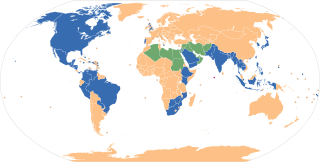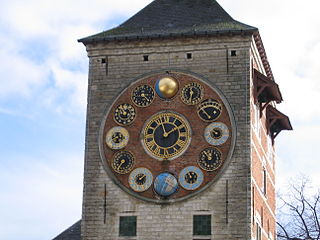Related Research Articles

The Hebrew calendar, also called the Jewish calendar, is a lunisolar calendar used today for Jewish religious observance and as an official calendar of Israel. It determines the dates of Jewish holidays and other rituals, such as yahrzeits and the schedule of public Torah readings. In Israel, it is used for religious purposes, provides a time frame for agriculture, and is an official calendar for civil holidays alongside the Gregorian calendar.

A week is a unit of time equal to seven days. It is the standard time period used for short cycles of days in most parts of the world. The days are often used to indicate common work days and rest days, as well as days of worship. Weeks are often mapped against yearly calendars, but are typically not the basis for them, as weeks are not based on astronomy.
A common year starting on Sunday is any non-leap year that begins on Sunday, 1 January, and ends on Sunday, 31 December. Its dominical letter hence is A. The most recent year of such kind was 2023 and the next one will be 2034 in the Gregorian calendar, or, likewise, 2018 and 2029 in the obsolete Julian calendar, see below for more.
A common year starting on Friday is any non-leap year that begins on Friday, 1 January, and ends on Friday, 31 December. Its dominical letter hence is C. The most recent year of such kind was 2021 and the next one will be 2027 in the Gregorian calendar, or, likewise, 2022 and 2033 in the obsolete Julian calendar, see below for more. This common year is one of the three possible common years in which a century year can begin on, and occurs in century years that yield a remainder of 100 when divided by 400. The most recent such year was 1700 and the next one will be 2100.
A common year starting on Monday is any non-leap year that begins on Monday, 1 January, and ends on Monday, 31 December. Its dominical letter hence is G. The most recent year of such kind was 2018 and the next one will be 2029 in the Gregorian calendar, or likewise, 2019 and 2030 in the Julian calendar, see below for more. This common year is one of the three possible common years in which a century year can begin on and occurs in century years that yield a remainder of 300 when divided by 400. The most recent such year was 1900 and the next one will be 2300.
Dominical letters or Sunday letters are a method used to determine the day of the week for particular dates. When using this method, each year is assigned a letter depending on which day of the week the year starts. The Dominical letter for the current year 2024 is GF.
A leap year starting on Sunday is any year with 366 days that begins on Sunday, 1 January, and ends on Monday, 31 December. Its dominical letters hence are AG. The most recent year of such kind was 2012 and the next one will be 2040 in the Gregorian calendar or, likewise 2024 and 2052 in the obsolete Julian calendar.
A common year starting on Tuesday is any non-leap year that begins on Tuesday, 1 January, and ends on Tuesday, 31 December. Its dominical letter hence is F. The most recent year of such kind was 2019 and the next one will be 2030, or, likewise, 2014 and 2025 in the obsolete Julian calendar, see below for more.
A leap year starting on Monday is any year with 366 days that begins on Monday, 1 January, and ends on Tuesday, 31 December. Its dominical letters hence are GF. The current year, 2024, is a leap year starting on Monday in the Gregorian calendar. The last such year was 1996 and the next such year will be 2052 in the Gregorian calendar or, likewise, 2008 and 2036 in the obsolete Julian calendar. 29 February falls on Thursday.
A common year starting on Wednesday is any non-leap year that begins on Wednesday, 1 January, and ends on Wednesday, 31 December. Its dominical letter hence is E. The most recent year of such kind was 2014, and the next one will be 2025 in the Gregorian calendar or, likewise, 2015 and 2026 in the obsolete Julian calendar, see below for more. This common year is one of the three possible common years in which a century year can begin on, and occurs in century years that yield a remainder of 200 when divided by 400. The most recent such year was 1800 and the next one will be 2200.
A leap year starting on Tuesday is any year with 366 days that begins on Tuesday, 1 January, and ends on Wednesday, 31 December. Its dominical letters hence are FE. The most recent year of such kind was 2008 and the next one will be 2036 in the Gregorian calendar or, likewise 2020 and 2048 in the obsolete Julian calendar.
A common year starting on Saturday is any non-leap year that begins on Saturday, 1 January, and ends on Saturday, 31 December. Its dominical letter hence is B. The most recent year of such kind was 2022 and the next one will be 2033 in the Gregorian calendar or, likewise, 2023 and 2034 in the obsolete Julian calendar. See below for more.
A leap year starting on Saturday is any year with 366 days that begins on Saturday, 1 January, and ends on Sunday, 31 December. Its dominical letters hence are BA. The most recent year of such kind was 2000 and the next one will be 2028 in the Gregorian calendar or, likewise 2012 and 2040 in the obsolescent Julian calendar. In the Gregorian calendar, years divisible by 400 are always leap years starting on Saturday. The most recent such occurrence was 2000 and the next one will be 2400, see below for more.
A leap year starting on Friday is any year with 366 days that begins on Friday 1 January and ends on Saturday 31 December. Its dominical letters hence are CB. The most recent year of such kind was 2016 and the next one will be 2044 in the Gregorian calendar or, likewise, 2000 and 2028 in the obsolete Julian calendar.
A leap year starting on Thursday is any year with 366 days that begins on Thursday 1 January, and ends on Friday 31 December. Its dominical letters hence are DC. The most recent year of such kind was 2004 and the next one will be 2032 in the Gregorian calendar or, likewise, 2016 and 2044 in the obsolete Julian calendar.
A leap year starting on Wednesday is any year with 366 days that begins on Wednesday 1 January and ends on Thursday 31 December. Its dominical letters hence are ED. The most recent year of such kind was 2020 and the next one will be 2048 in the Gregorian calendar, or likewise, 2004 and 2032 in the obsolete Julian calendar, see below for more.

The Doomsday rule, Doomsday algorithm or Doomsday method is an algorithm of determination of the day of the week for a given date. It provides a perpetual calendar because the Gregorian calendar moves in cycles of 400 years. The algorithm for mental calculation was devised by John Conway in 1973, drawing inspiration from Lewis Carroll's perpetual calendar algorithm. It takes advantage of each year having a certain day of the week upon which certain easy-to-remember dates, called the doomsdays, fall; for example, the last day of February, 4/4, 6/6, 8/8, 10/10, and 12/12 all occur on the same day of the week in any year.
The ISO week date system is effectively a leap week calendar system that is part of the ISO 8601 date and time standard issued by the International Organization for Standardization (ISO) since 1988 and, before that, it was defined in ISO (R) 2015 since 1971. It is used (mainly) in government and business for fiscal years, as well as in timekeeping. This was previously known as "Industrial date coding". The system specifies a week year atop the Gregorian calendar by defining a notation for ordinal weeks of the year.

The Zimmer tower is a tower in Lier, Belgium, also known as the Cornelius tower, that was originally a keep of Lier's 14th-century city fortifications. In 1930, astronomer and clockmaker Louis Zimmer (1888–1970) built the Jubilee Clock, which is displayed on the front of the tower, and consists of 12 clocks encircling a central one with 57 dials. These clocks showed time on all continents, phases of the moons, times of tides and many other periodic phenomena.
References
- 1 2 Robert van Gent (2017). "The Mathematics of the ISO 8601 Calendar". Utrecht University, Department of Mathematics. Retrieved 20 July 2017.